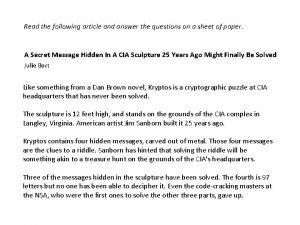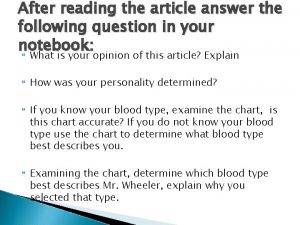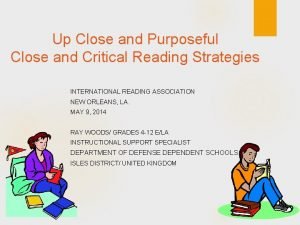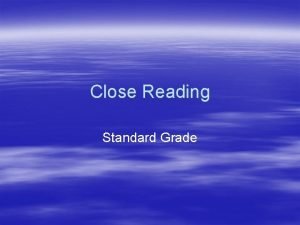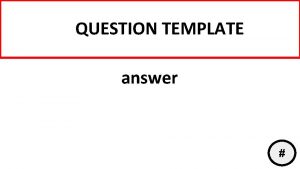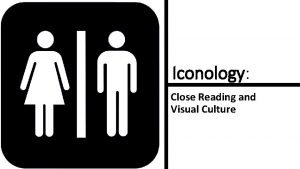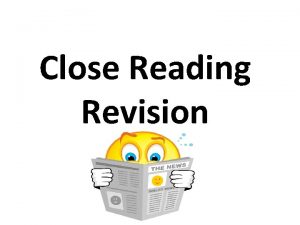Close Reading Question Types and How to Answer








- Slides: 8

Close Reading Question Types and How to Answer Them • Tone • IMAGERY • Context • Li. NK • STRUCTURE • Word choice

Tone • • "Of all the gin joints in all the towns in all the world, she walks into mine. " Question: How has the writer created a particular tone? 1. Identify tone. Disbelieving 2. Explain if it was a feature of LANGUAGE or STRUCTURE that enabled you to identify tone. Structure: repetition. 3. QUOTE feature AND explain HOW it helped you to identify. Repetition of “all” highlights the sheer number of possible gin joints “she” could have walked into, and his subsequent disbelief that despite this, she has ended up in his. Example:

Tone "Well, here's another nice mess you've gotten me into!“ • Question: How has the writer created a particular tone? • 1. Identify tone. Sarcastic • 2. Explain whether it was a feature of LANGUAGE or STRUCTURE that enabled you to identify tone. Language: oxymoron. • 3. QUOTE feature AND explain HOW it helped you to identify. “Nice mess” is an oxymoron; a mess is not usually nice, so he is clearly being sarcastic.

IMAGERY • “I have mountains of homework” • Question: How has imagery been used effectively to convey how much homework the writer has to do? • 1. Identify technique AND quote = metaphor: “mountains”. • 2. Explain literal meaning = very large hill / arduous and difficult to climb. • 3. Explain metaphorical meaning = a vast size and challenge. • 4. Relate to actual context / question = successfully highlights the sheer amount of homework the person has to tackle and implies that undertaking it will be challenging and hard work.

Context The river was a treacherous cascade of black whirlpool and foaming rapid. • Question: Explain how the context helped you to understand the meaning of “treacherous”. • 1. Explain (in your own words!) what the word means. • • “Treacherous” means dangerous. • The writer describes the river as having “whirlpools” and “rapids” which are both dangerous features of a river in which a person could drown. 2. QUOTE and explain (in your own words!) HOW the context (the words / phrase around the word) helped you to arrive at the meaning.

Li. NK QUESTi. ONS • The female polar bear is a fearsome predator. However, they are also caring and loving mothers. • • Question: Explain how “However…mothers” acts as an effective link sentence. 1. Sum up (own words) central idea and quote (briefly) from previous sentence (or paragraph). The previous sentence shows the dangerous side of the polar bear: “fearsome predator”. 2. Identify link word. “However” links the two ideas and introduces the contrasting idea to be shown in the next sentence. 3. Sum up (own words) central idea and quote (briefly) from following sentence (or paragraph). The following sentence shows the more tender side of the polar bear: “caring and loving mothers”.

STRUCTURE § “I’ll be back. ” § Q: How does the sentence structure effectively convey the character’s intentions? § 1. Identify feature of structure and type of sentence. § Statement and short sentence. § 2. Explain effect. § “will” creates statement of intent / shortness contributes to impact of assertion. § 3. Relate to question. § The short sentence delivers greater impact to the statement of assertion, effectively conveying the character’s clear intention to return.

Word choice • The duckling flapped through the air. • The eagle soared through the air. • • Note: The denotation (literal meaning) of both “flapped” and “soared” is to fly. However, the different words are chosen based on their connotations (what ideas we associate with the word). We would not say the duckling “soared” through the air! Question: Identify an example of word choice and explain why it is effective in conveying the bird’s style of flight. 1. QUOTE WORD. “soared” 2. EXPLAIN DENOTATION AND CONNOTATIONS. “soared” means to fly; its connotations are of grace, smoothness and grandeur. 3. RELATE TO ACTUAL CONTEXT / QUESTION. “soared” is a successful example of word choice as its connotations of grace and smoothness effectively convey the majesty of an eagle’s flight.





